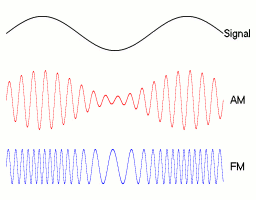Frequency Modulation (FM) is the encoding of information in a carrier wave by varying the instantaneous frequency of the wave. The technology is used in telecommunications, radio broadcasting, signal processing, and computing. Also see Frequency.
Varying the frequency of the waves of a carrier in order to transmit analog or digital data. FM is widely used in audio transmission, not only for its namesake FM radio, but for the audio channels in television.
Digital data can be encoded and transmitted with a type of frequency modulation known as Frequency-Shift Keying (FSK), in which the instantaneous frequency of the carrier is shifted among a set of frequencies. The frequencies may represent digits, such as 0 and 1.
Frequency modulation and phase modulation are the two complementary principal methods of angle modulation. Phase modulation is often used as an intermediate step to achieve FM. These methods contrast with Amplitude Modulation (AM), in which the amplitude of the carrier wave varies, while the frequency and phase remain constant.
FM is the most common analog modulation skill in mobile communication systems. High frequency PCB modulation is the process of processing the coding information of signal source to make it suitable for transmission. Generally, this means the baseband signal is transformed into a ban communication signal with a very high frequency relative to the baseband frequency. This band communication signal is called Modulated Signal, and the baseband signal is called Modulated Signal. Modulation can be accomplished by changing the fluctuation, phase or frequency of the high frequency carrier with the fluctuation of the signal. Demodulation is the process of extracting the baseband signal from the carrier for the predetermined receiver (sink) to process and understand.

